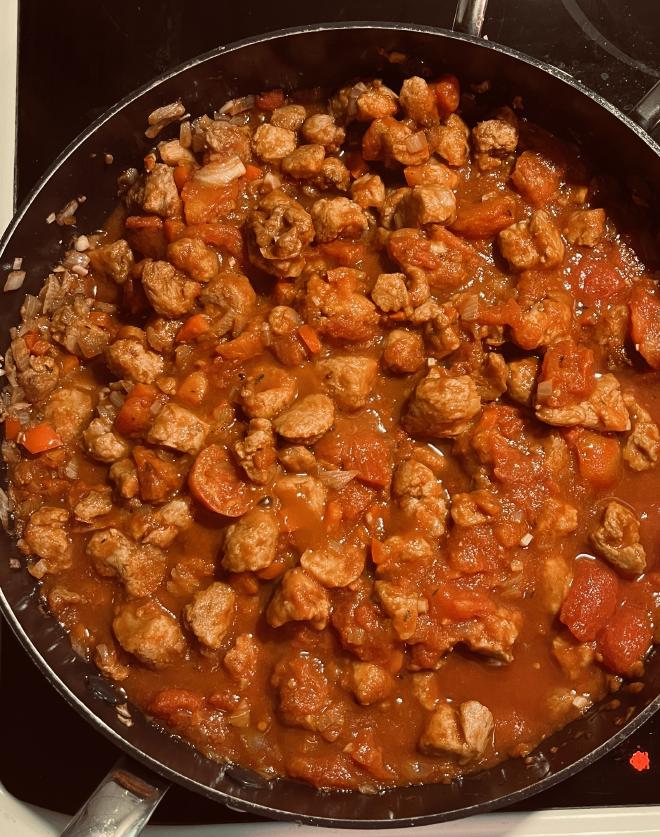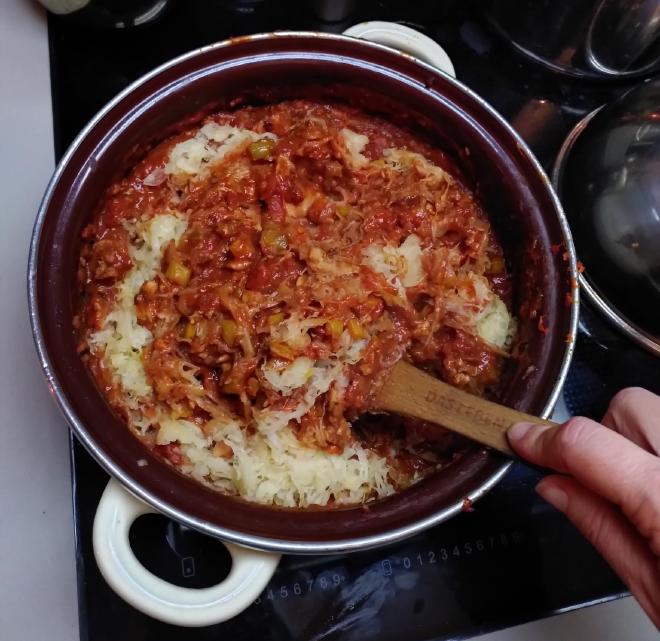Vegetarian Goulash (in Two Variations)
Table of Contents
Jump to Recipe
Jump to Carbon Footprint
When autumn arrives, goulash is simply a wonderfully warming dish. Traditionally made with beef or pork, it is easy to make a vegetarian version - not least because the flavour comes from the well-seasoned sauce. The best vegetarian option is to use soya protein chunks, which are briefly blanched and then left to soak for a while.
In this article you will find two variations of vegetarian goulash: a classic version and a vegetarian version of Szegedin goulash. This second version is prepared with a little sour cream or sour cream and sauerkraut. The sauerkraut may sound unusual at first, but the well-seasoned sauce is a good counterbalance to the hearty goulash. Sauerkraut is usually added to the goulash just before serving. If you’re not sure about the acidity, you can serve it separately and mix it on the plate.

My grandparents made Szeged goulash regularly when I was growing up, partly because my grandfather was originally from Hungary and his family brought the dish with them to Germany. I can’t remember ever eating it outside of my family, but it’s just too good not to share. (And it’s a little nod to someone who means a lot to me.)
The classic goulash is vegan, the Szeged version is “only” vegetarian because of the sour cream - but this can easily be replaced with a plant-based alternative.
There are many different accompaniments to goulash - from pasta to potatoes, from Bohemian dumplings to bread. I use Ebly in this recipe because I really like its light bite.

Recipe #
Vegetarian Goulash
60 minutes
2 portions
Ingredients #
For the soya slices and their marinade:
- 100 g dried soya protein chunks (coarse)
- 2 tsp dried vegetable stock
- 20 ml soya sauce
- 1 tbsp oil
- 2 tsp dried paprika (sweet)
- 1 tsp dried paprika (hot)
- 10 g mustard
For the goulash:
- 1 large onion
- 1 garlic clove
- 1 red bell pepper
- 3 tablespoons olive oil
- 30 g tomato puree
- 2 tablespoons flour
- 100 ml red wine
- 1 tin of tomatoes (400 g)
- 1 teaspoon dried paprika (sweet)
- 1/2 teaspoon dried paprika (hot)
- 1 tsp marjoram
- 1 pinch of pepper
- as a side dish: 100 g durum wheat berries (Ebly)
- 1 pinch of salt
For the Szeged goulash version:
- 2 tablespoons sour cream, sour cream or crème fraîche
- 150 g sauerkraut
Directions #
- Pour three times the amount of boiling water over the dried soya protein chunks. Add the dried vegetable stock, stir and leave to soak for 10-15 minutes.
- Meanwhile, stir together the soya sauce, oil, paprika and mustard to make a marinade. Drain the excess water from the soya chunks, then mix the chunks and marinade together. Leave to marinate overnight, or for a shorter time if necessary.
- Heat the oil in a frying pan. Brown the soya chunks on all sides.
- While the soya chunks are frying, you can peel and chop the onion and garlic. Wash and chop the bell peppers.
- When the soya chunks are fried, remove them from the pan, add a little more oil to the pan and fry the onion and garlic cubes over a medium heat.
- After about 3 minutes, add the bell peppers and fry for another 5 minutes. Add the tomato paste and flour to the frying pan and fry for just under a minute. Deglaze with red wine, reduce briefly and add the tomatoes and soya chunks. Bring to the boil briefly, then reduce the heat, add the remaining spices and simmer gently with the lid on.
- While the goulash is cooking, prepare the Ebly: Bring to the boil with double to triple the amount of water and a little salt or vegetable stock, then leave to simmer for about 10 minutes.
- For the Szegedin goulash version, heat the sauerkraut in a pan, add the sour cream just before serving and stir briefly. Mix the sauerkraut with the goulash just before serving.
- Serve the goulash with the Ebly.
Carbon Footprint #
In order to be able to compare the classic vegetarian goulash with the vegetarian Szegediner goulash, I have adjusted the quantities for the Szegediner goulash so that both recipes have the same weight of ingredients.
In total, two portions of the classic vegetarian goulash have an estimated carbon footprint of 1582 g. In the case of the vegetarian Szegediner goulash, two portions have an estimated carbon footprint of 1612 g.
This ranks it number 31 out of 57 recipes published on the blog so far in terms of estimated carbon footprint.
The carbon footprint of the recipe is therefore slightly higher than the average of the other recipes here on the blog: At least 50% of the recipes cause less emissions, but it is not yet in the worst third of the recipes. 🤨Looking at the individual ingredients, it is noticeable that the unprocessed ingredients have a relatively good carbon footprint: Onions and peppers together account for just over 20% of the weight of the ingredients, but only about 7% of the greenhouse gas balance. The more processed ingredients, such as oil, tomato paste or tinned tomatoes, have an above-average contribution to emissions. This is particularly noticeable in the case of tomatoes: While canned tomatoes have a carbon footprint of 1.8 kg per kilo of food, fresh tomatoes have an average of 0.8 kg of CO2 equivalent emissions per kilo of tomatoes, and seasonal tomatoes from Germany have a carbon footprint of only 0.3 kg per kilo of tomatoes. The difference is due to processing, packaging and additional transport. Soya chunks and wine are the two exceptions, where more processed foods have a below-average contribution to the carbon footprint. In the Szeged Goulash version, sour cream accounts for just under 5% of the climate impact - like other dairy products, this tends to be above average, but we use so little of it that it hardly makes a difference to the overall balance of the recipe.
Veggie goulash #
Here you will find an overview of the effects of the individual ingredients for the classic vegetarian goulash.
The complete overview of all ingredients for the vegetarian goulash can be found here in the table:
| ingredient | carbon footprint per kg | carbon footprint (in g) for 2 servings | % of ingredients | % of CO2 emissions |
|---|---|---|---|---|
| Soya chunks | 1.0 | 100 | 9% | 6% |
| Vegetable stock | 0.3 | 6 | 2% | 0% |
| Soya sauce | 0.2 | 4 | 2% | 0% |
| Oil | 3.2 | 32 | 1% | 2% |
| Paprika, dried | 1.1 | 7 | 1% | 0% |
| Mustard | 1.4 | 14 | 1% | 1% |
| Onion | 0.2 | 20 | 9% | 1% |
| Garlic | 0.5 | 1 | 0% | 0% |
| Paprika | 0.6 | 93 | 14% | 6% |
| Oil | 3.2 | 96 | 3% | 6% |
| Tomato paste | 4.3 | 129 | 3% | 8% |
| Flour | 0.9 | 13 | 1% | 1% |
| Red wine | 1.0 | 100 | 9% | 6% |
| Canned tomatoes | 1.8 | 720 | 36% | 46% |
| Paprika, dried | 1.1 | 6 | 0% | 0% |
| Marjoram | 1.1 | 2 | 0% | 0% |
| Pepper | 1.2 | 1 | 0% | 0% |
| Tender wheat / Ebly | 1.3 | 132 | 9% | 8% |
| Salt | 0.7 | 1 | 0% | 0% |
| Cook soya chunks | 1 | 0% | ||
| Cook goulash | 81 | 5% | ||
| Cook Ebly | 21 | 1% |
Szeged veggie goulash #
Below you will find a graphic overview of the ingredients in the vegetarian Szeged goulash.
Here you will find the detailed ingredients table for the vegetarian Szeged goulash:
| ingredient | carbon footprint per kg | carbon footprint (in g) for 2 servings | % of ingredients | % of CO2 emissions |
|---|---|---|---|---|
| Soya chunks | 1.0 | 85 | 8% | 5% |
| Vegetable stock | 0.3 | 5 | 2% | 0% |
| Soya sauce | 0.2 | 4 | 2% | 0% |
| Oil | 3.2 | 27 | 1% | 2% |
| Paprika, dried | 1.1 | 6 | 0% | 0% |
| Mustard | 1.4 | 12 | 1% | 1% |
| Onion | 0.2 | 17 | 8% | 1% |
| Garlic | 0.5 | 1 | 0% | 0% |
| Paprika | 0.6 | 79 | 12% | 5% |
| Oil | 3.2 | 81 | 2% | 5% |
| Tomato paste | 4.3 | 109 | 2% | 7% |
| Flour | 0.9 | 11 | 1% | 1% |
| Red wine | 1.0 | 85 | 8% | 5% |
| Canned tomatoes | 1.8 | 610 | 31% | 38% |
| Paprika, dried | 1.1 | 5 | 0% | 0% |
| Marjoram | 1.1 | 2 | 0% | 0% |
| Pepper | 1.2 | 1 | 0% | 0% |
| Tender wheat / Ebly | 1.3 | 112 | 8% | 7% |
| Salt | 0.7 | 1 | 0% | 0% |
| Sauerkraut | 1.3 | 188 | 14% | 12% |
| Sour cream | 3.0 | 60 | 2% | 4% |
| Cook soya chunks | 1 | 0% | ||
| Cook goulash | 81 | 5% | ||
| Cook Ebly | 21 | 1% | ||
| Cook sauerkraut | 10 | 1% |


